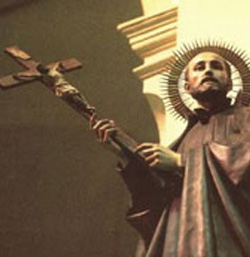Saint of the Day Online - St. Ailbe
Saint of the day online, Monday, September 12, 2017
12-09-2017
Saint Name: St Ailbe
Place: Ireland
Birth:5th C
Death:528, 12 Sep
Feast: September 12
St Ailbe is called a "second Patrick and patron of Munster", Bishop and preacher, one of the saints whose life has been woven into the myths and legends of Ireland. He was a known disciple of St. Patrick, and is called Albeus in some records. What is known about Ailbhe is that he was a missionary in Ireland, perhaps sponsored by King Aengus of Munster. He was also the first bishop of Emily in Munster, Ireland.
Legends and traditions abound about his life. One claims that he was left in the woods as an infant and suckled by a wolf. This legend is prompted in part by Ailbhe's later life. An old she-wolf came to Ailbhe for protection from a hunting party, resting her head upon his breast. He is supposed to have been baptized by a priest in northern Ireland, possibly in a British settlement. The so called Acts of Ailbhe are filled with traditions that are not reliable. Ailbhe was noted for his charity and kindness, as well as his eloquent sermons. He is beloved in Ireland.
Ailbhe was said to have founded the monastery and diocese of Emly, which became very important in Munster. He was said to have been responsible for King Aengus's donation of island lands for Saint Enda's monastery.
The name Ailbe was explained in the Vita Albei as derivative of ail 'a rock' and beo, 'living'. In the words of Baring Gould and Fisher [36] this is “a very doubtful etymology”. It is clearly related to the story of his being exposed at birth behind a rock, before being cared for by a wolf (Vita Albei 2) and looks very much like a folk-etymology. Nevertheless, we can note a sporadic association of Ailbe (as saint or mythological figure) with ' rocks' (Irish ail). The Lia Ailbe (stone of Ailbe) on the Magh Ailbe (plain of Ailbe) may be in origin tautological, while a Sliabh Ailbe was associated with a legendary figure Ailbe in Duanaire Finn. The Inbher Ailbhine mentioned in Tirechan's Vita Patricii (Tirechan 5.2) may contain ail, ‘a rock’, according to Watson. It is at a “marvellous stone altar” ( = prominent rock with religious associations ?) “on the mountain of the Ui Ailello” where Patrick was said to have installed the second St Ailbe (of Sencua) - probably at the old site of the church of Shancoe, County Sligo, where a large rock overlooks a well:. This might all be best explained by a typical process of sound assimilation of ail 'a rock' to the name ail-be.
Source of info - wiki